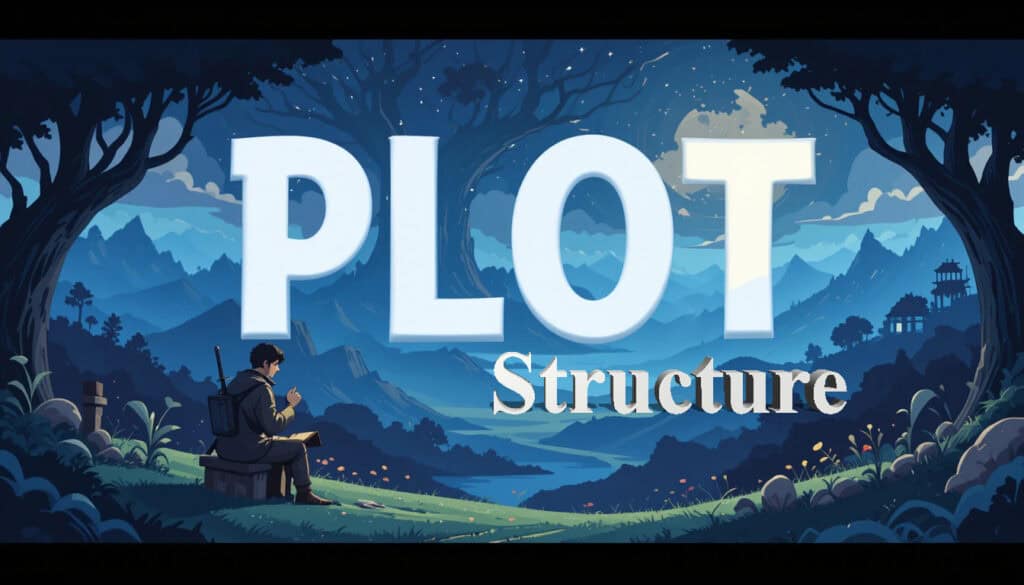Table of Contents
Introduction: Plot Structure as a Mirror of the Mind
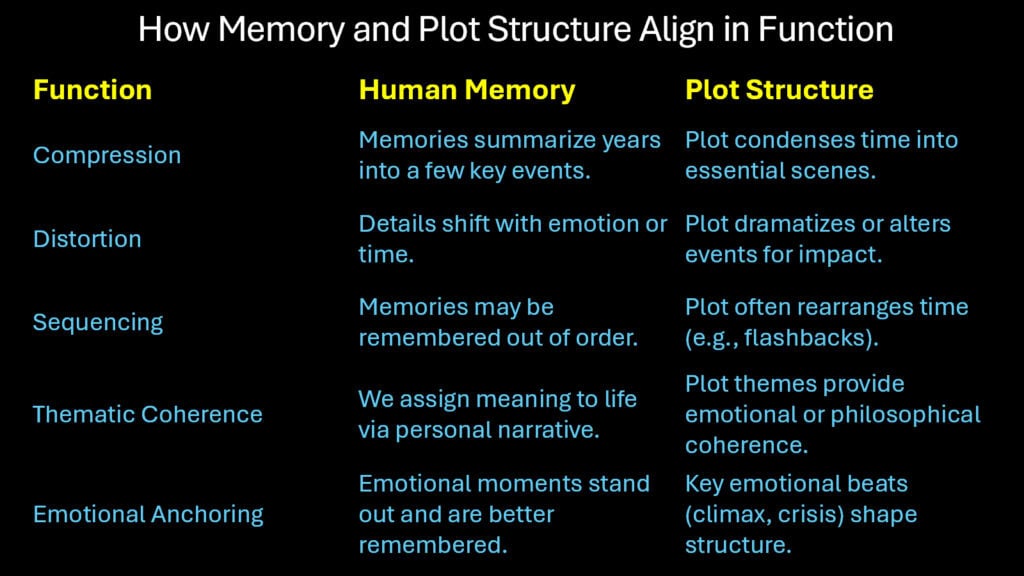
Stories have haunted humanity since we first gathered around fires. They persist because they echo something deeper than entertainment—they mirror the very architecture of our minds. Plot structure isn’t just a tool for organizing events in fiction; it reflects how humans store, distort, and relive memories.
Consider how you remember your childhood. Not as a linear progression of days, but as vivid snapshots—your first day of school, a summer thunderstorm, the taste of birthday cake. These memories don’t follow chronological order. They cluster around emotional peaks and valleys, just like the beats in a well-crafted story. Memory researchers refer to this phenomenon as the “reminiscence bump,” which indicates that we tend to remember a greater number of events from our teenage years and early adulthood compared to other stages of life.
Plot structure operates on similar principles. It doesn’t simply record events but shapes them into patterns that feel meaningful. The inciting incident, rising action, climax, and resolution don’t just organize narrative—they replicate how our minds naturally process experience. When we encounter conflict, build tension, and seek resolution in stories, we’re engaging with the same cognitive processes that help us make sense of our own lives.
This connection runs deeper than simple analogy. Neuroscience reveals that our brains construct memories much like authors construct plots. We don’t store experiences as faithful recordings but as reconstructed narratives, complete with gaps, embellishments, and emotional coloring. The human brain functions fundamentally as a storytelling apparatus, perpetually transforming the disorder of experiences into structured narratives.
The following exploration reveals six remarkable ways plot structure mirrors memory’s operation. We’ll discover how stories capture emotional flashbulb moments, create meaningful chunks of information, and even mirror our capacity for forgetting. Through this lens, we can understand why certain stories resonate so powerfully and why storytelling feels so fundamentally human.
| Memory Process | Plot Structure Element | Psychological Function |
|---|---|---|
| Emotional encoding | Climactic moments | Heightens recall and meaning |
| Episodic clustering | Act structure | Organizes experience into meaningful units |
| Narrative coherence | Character arcs | Creates identity and continuity |
| Selective retention | Omitted details | Focuses attention on significance |
1. Plot Structure as a Series of Flashbulb Memories
The human mind doesn’t record everything equally. Instead, it creates what psychologists call “flashbulb memories”—extraordinarily vivid recollections of emotionally significant events. These memories feel photographically clear because intense emotion acts like a cognitive spotlight, illuminating details while casting others into shadow.
Plot structure operates through the same principle. Stories don’t give equal weight to every moment but concentrate on emotional peaks—the moments that matter most. The inciting incident, midpoint crisis, and climax function as narrative flashbulbs, burning themselves into readers’ memories with startling clarity. These beats carry the story’s emotional weight, just as traumatic or joyful events anchor our personal histories.
Psychological realism as a literary framework helps explain this phenomenon. This approach recognizes that human experience isn’t neutral or objective but colored by emotion and perception. Writers using psychological realism don’t just describe events—they capture the subjective experience of living through them. Virginia Woolf’s stream-of-consciousness technique in “Mrs. Dalloway” exemplifies this approach, showing how Clarissa’s memories surface not chronologically but according to their emotional resonance.
The parallel between flashbulb memories and plot structure explains why certain stories lodge so deeply in our consciousness. When authors craft scenes with emotional intensity, they’re activating the same neural pathways that create our most vivid personal memories. The death of a beloved character, a moment of profound realization, or a climactic confrontation—these plot beats mirror the kinds of experiences that become foundational memories in our own lives.
This connection also explains why plot structure feels natural rather than artificial. We don’t experience life as a series of equally weighted events but as a landscape of emotional peaks and valleys. Stories that honor this pattern feel true to human experience, while those that ignore it often feel flat or unconvincing.
| Flashbulb Memory Triggers | Plot Structure Equivalents | Examples in Literature |
|---|---|---|
| First experiences | Inciting incidents | Harry Potter receiving his Hogwarts letter |
| Loss and grief | Character deaths | The death of Ned Stark in “Game of Thrones” |
| Moments of triumph | Climactic victories | Frodo destroying the Ring |
| Revelations and discoveries | Plot twists | The revelation of Darth Vader’s identity |
2. Plot Structure as a Memory Loop, Not a Straight Line
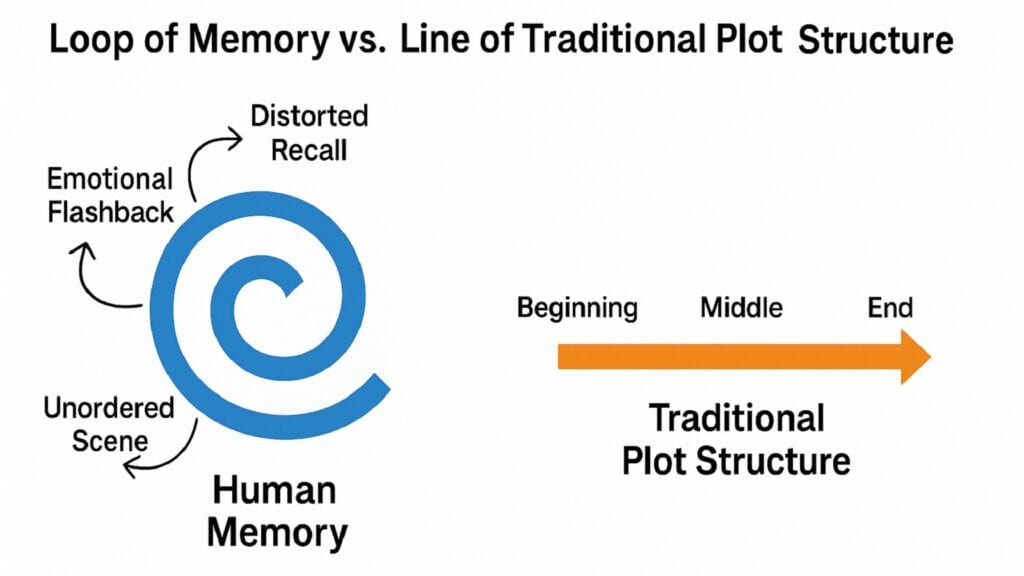
Traditional plot diagrams suggest stories move in straight lines—exposition, rising action, climax, falling action, resolution. But human memory doesn’t work this way. Our minds return obsessively to certain moments, circling back to experiences that shaped us. We remember in loops, spirals, and sudden jumps rather than orderly progressions.
Modern storytelling increasingly reflects this nonlinear reality. Films like “Memento” and “Eternal Sunshine of the Spotless Mind” don’t just use memory as a theme—they structure themselves like memory itself, moving backward, forward, and sideways through time. These narratives feel authentic because they mirror how we actually experience remembering.
Memory researchers describe this phenomenon as “reminiscence,” where certain experiences resurface repeatedly throughout our lives, gaining new meaning with each revisit. A childhood trauma might resurface during therapy, in dreams, or triggered by seemingly unrelated events. Each return adds layers of interpretation and emotional complexity.
Plot structure in sophisticated narratives mirrors this looping quality. Stories weave between past and present, revealing information through flashbacks, flash-forwards, and fragmented revelations. Characters don’t simply move forward but revisit past events, seeing them with new understanding. This structure acknowledges that understanding often comes not from linear progression but from circling back to experiences with fresh perspective.
The loop structure also explains why certain stories demand rereading. Just as our minds return to significant memories, readers return to meaningful stories, discovering new layers with each encounter. The nonlinear structure invites this kind of revisiting, revealing details and connections that weren’t apparent on first reading.
| Memory Loop Characteristics | Nonlinear Plot Techniques | Narrative Effect |
|---|---|---|
| Recurring themes | Motifs and symbols | Deepens emotional resonance |
| Circular patterns | Framing devices | Creates narrative symmetry |
| Temporal jumps | Flashbacks and flash-forwards | Reveals character psychology |
| Layered meaning | Multiple perspectives | Encourages rereading |
3. Plot Structure as Cognitive Chunking for Meaning
Human memory operates through a process called “chunking”—organizing information into meaningful clusters rather than storing isolated details. We remember phone numbers by grouping digits, recall stories by organizing events into scenes, and understand complex concepts by breaking them into manageable pieces.
Plot structure serves as a sophisticated chunking system. Acts, scenes, and chapters don’t just organize narrative for convenience—they mirror how our minds naturally process information. Each structural unit contains a complete thought or emotional arc, making the story digestible and memorable.
Structuralism as a literary theory framework illuminates this process. Structuralists like Claude Lévi-Strauss argued that human minds seek patterns and organize experience into binary oppositions and hierarchical systems. Plot structure reflects these cognitive patterns, organizing narrative into recognizable shapes that feel satisfying because they align with how we process information.
The three-act plot structure exemplifies this chunking principle. Act One establishes the world and conflict, Act Two develops complications and deepens stakes, Act Three resolves tensions and provides closure. This pattern feels natural because it mirrors how we process any complex experience—first understanding the situation, then navigating complications, finally reaching resolution.
Even within acts, scenes function as smaller chunks. Each scene typically contains a complete action or revelation, giving readers a sense of progress and accomplishment. This structure prevents cognitive overload by breaking the narrative into manageable pieces while maintaining overall coherence.
The chunking principle explains why certain story structures feel more satisfying than others. When authors organize their narratives into clear, meaningful units, readers can follow the story without becoming lost or overwhelmed. The structure supports comprehension and retention, making the story more likely to lodge in memory.
| Elements of Plot Structure | Chunking Function | Memory Enhancement |
|---|---|---|
| Acts | Major narrative divisions | Provides overall framework |
| Scenes | Specific events or encounters | Creates memorable moments |
| Chapters | Thematic or temporal units | Offers natural stopping points |
| Beats | Moment-to-moment changes | Maintains narrative rhythm |
4. Plot Structure as Emotional Echo
Memory isn’t just about facts—it’s deeply emotional. When we recall significant events, we don’t just remember what happened but how it felt. The emotional aspects of memories frequently demonstrate greater resilience than the factual elements. We might forget exactly what someone said but remember the hurt or joy their words created.
Plot structure mirrors this emotional dimension through its rhythm of tension and release. Stories build toward emotional climaxes, then provide cathartic resolution. This pattern echoes how we emotionally process our own experiences, cycling through periods of stress and relief, conflict and resolution.
The emotional rhythm of plot structure also reflects how we revisit memories over time. Traumatic experiences often resurface with their original emotional intensity, while positive memories can provide comfort during difficult periods. Stories that capture this emotional echo feel particularly resonant because they activate the same emotional patterns we experience in our own lives.
Consider how different genres create distinct emotional rhythms. Horror builds tension through escalating threat, then releases it through revelation or escape. Romance creates tension through obstacles to love, then resolves it through union. These patterns don’t just entertain—they exercise our emotional muscles, providing safe spaces to experience intense feelings.
The emotional echo principle also explains why certain stories affect us so powerfully. When a narrative’s emotional rhythm aligns with our own psychological patterns, it can trigger profound responses. Readers might find themselves crying at fictional losses or celebrating fictional victories because the story’s emotional structure resonates with their own emotional memories.
| Emotional Pattern | Plot Structure | Psychological Function |
|---|---|---|
| Tension and release | Crisis and resolution | Provides cathartic experience |
| Hope and disappointment | Reversals and setbacks | Builds emotional resilience |
| Fear and relief | Suspense and revelation | Exercises anxiety responses |
| Loss and acceptance | Tragedy and resolution | Processes grief and healing |
5. Plot Structure as a Constructed Narrative Self
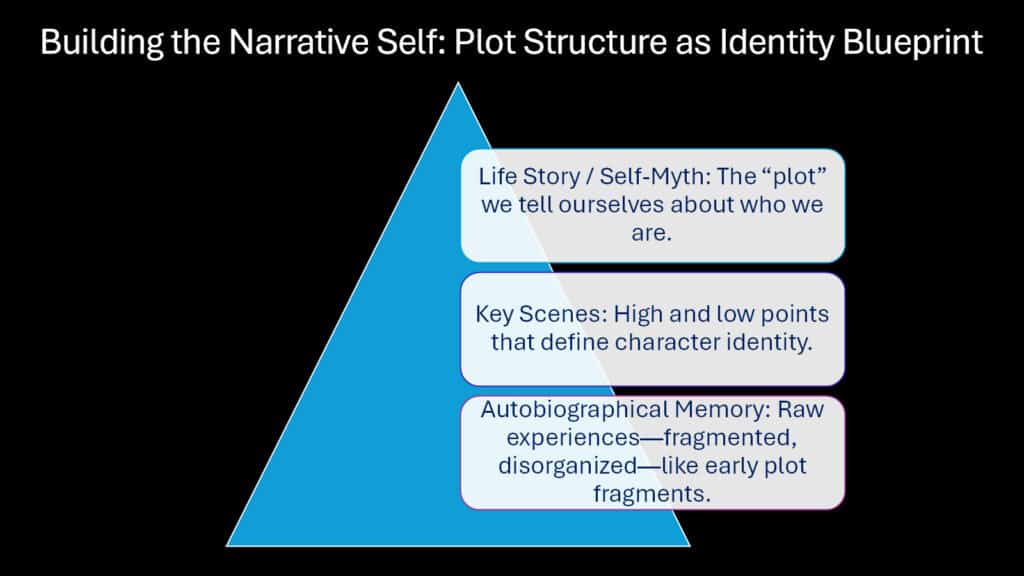
Psychologists have discovered that human identity isn’t fixed but constructed through narrative. We create coherent senses of self by weaving our experiences into stories that explain who we are and how we became that way. This process, called “narrative identity,” transforms the chaos of experience into meaningful personal mythology.
Plot structure in fiction mirrors this psychological process. Characters don’t just experience events—they develop through narrative arcs that give their lives purpose, meaning, and direction. The hero’s journey, character development arcs, and transformation plots all reflect how humans construct identity through storytelling.
Narrative Identity Theory, developed by psychologist Dan McAdams, explains how people create life stories that provide unity and purpose. These personal narratives typically include origin stories, turning points, and future projections—elements that correspond directly to plot structure components like backstory, inciting incidents, and resolution.
The connection between character growth and the development of identity is profound. Just as fictional characters face obstacles that reveal their true nature, humans use challenges and conflicts to understand themselves better. The plot beats that drive character change—moments of crisis, revelation, and growth—mirror the experiences that shape our own sense of self.
This connection explains why readers often identify strongly with fictional characters. When a character’s journey resonates with our own experience of growth and change, we see our own struggles reflected in their story. The character’s narrative arc becomes a template for understanding our own life’s meaning.
Plot structure also reflects how we construct coherent identities from fragmented experiences. Just as authors weave disparate events into meaningful narratives, humans select and organize memories to create coherent self-stories. Both processes involve choosing which details to emphasize and which to omit in service of a larger meaning.
| Identity Construction Element | Plot Structure Parallel | Psychological Purpose |
|---|---|---|
| Origin stories | Character backstory | Explains current identity |
| Turning points | Inciting incidents | Marks significant change |
| Growth through conflict | Character development arcs | Demonstrates personal evolution |
| Future aspirations | Story resolution | Provides direction and hope |
6. Plot Structure as a Tool of Forgetting and Omissions
Memory isn’t just about what we remember—it’s equally about what we forget. The human brain actively discards information, keeping only what seems significant or emotionally relevant. This selective process isn’t a flaw but a feature, allowing us to focus on meaning rather than drowning in detail.
Plot structure operates through similar principles of omission. Stories don’t include every detail of characters’ lives but carefully select which moments to dramatize and which to skip. These omissions aren’t accidents but deliberate choices that focus attention on what matters most. The gaps between scenes, the unexplored backstories, and the unresolved questions all serve narrative purposes.
What stories leave out often proves as important as what they include. The silences between words, the years skipped in time jumps, and the perspectives left unexplored create spaces for readers to fill with their own experiences and interpretations. These omissions make stories feel alive and mysterious rather than exhaustively complete.
The selective nature of plot structure mirrors memory’s bias toward significance. Just as our minds retain emotionally charged moments while discarding routine details, stories focus on moments of high drama while glossing over mundane activities. This selective attention helps both memory and narrative maintain focus and meaning.
Plot structure’s omissions also reflect how memory serves identity construction. We remember events that support our self-concept while forgetting those that contradict it. Similarly, narrative perspective shapes which details authors include and which they omit, creating specific impressions and interpretations.
The power of omission explains why some stories feel more profound than others. Works that leave strategic gaps invite readers to participate actively in meaning-making, creating more engaging and memorable experiences than stories that explain everything explicitly.
| Type of Omission | Plot Structure Function | Memory Parallel |
|---|---|---|
| Temporal gaps | Time jumps between scenes | Forgetting routine periods |
| Backstory mysteries | Unexplored character history | Repressed or lost memories |
| Perspective limits | Single viewpoint narration | Subjective memory bias |
| Unresolved questions | Open endings | Incomplete understanding |
Conclusion: Plot Structure and the Architecture of Remembering
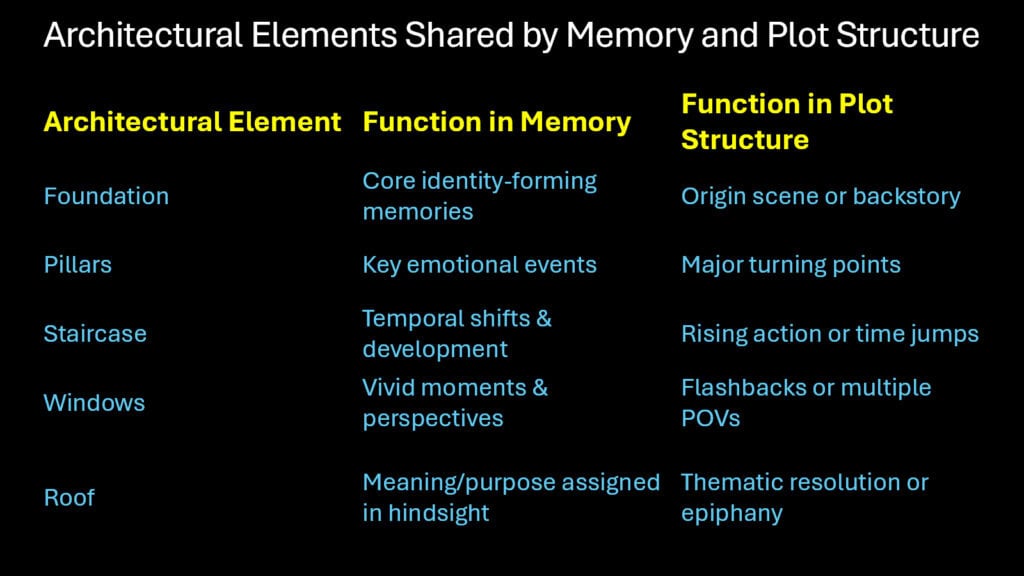
Stories endure because they speak to something fundamental about human consciousness. Plot structure doesn’t just organize narrative events—it reflects the deep patterns of how our minds work. From the emotional intensity of flashbulb memories to the selective nature of forgetting, stories mirror memory’s essential characteristics.
This connection reveals why storytelling feels so natural and necessary. We don’t just enjoy stories as entertainment but need them as tools for understanding ourselves and our world. Plot structure provides a framework for processing experience, making sense of chaos, and constructing meaning from the fragments of our lives.
The parallels between plot structure and memory also explain why certain stories resonate across cultures and centuries. Stories that honor memory’s natural patterns—its emotional rhythms, its circular nature, its selective focus—feel true to human experience regardless of their specific content. They tap into universal cognitive processes that transcend cultural boundaries.
Understanding these connections can deepen our appreciation for both storytelling and memory. Stories aren’t just fictional constructs but sophisticated tools for exploring consciousness itself. They reveal how our minds work, what we value, and how we create meaning from experience.
The architecture of remembering shapes not just our personal histories but our collective narratives. The stories we tell and retell become part of cultural memory, shaping how future generations understand their world. Plot structure serves as the blueprint for these cultural memories, ensuring that significant experiences pass from one generation to the next.
Perhaps most importantly, recognizing the connection between plot structure and memory can help us become better storytellers in our own lives. By understanding how narrative patterns create meaning, we can craft more coherent and satisfying personal stories. We can learn to structure our experiences in ways that promote growth, healing, and understanding.
| Memory Architecture Element | Plot Structure Reflection | Human Significance |
|---|---|---|
| Emotional encoding | Dramatic emphasis | Creates lasting impact |
| Selective retention | Strategic omission | Focuses on meaning |
| Narrative coherence | Character development | Builds identity |
| Pattern recognition | Structural repetition | Enables learning and growth |

